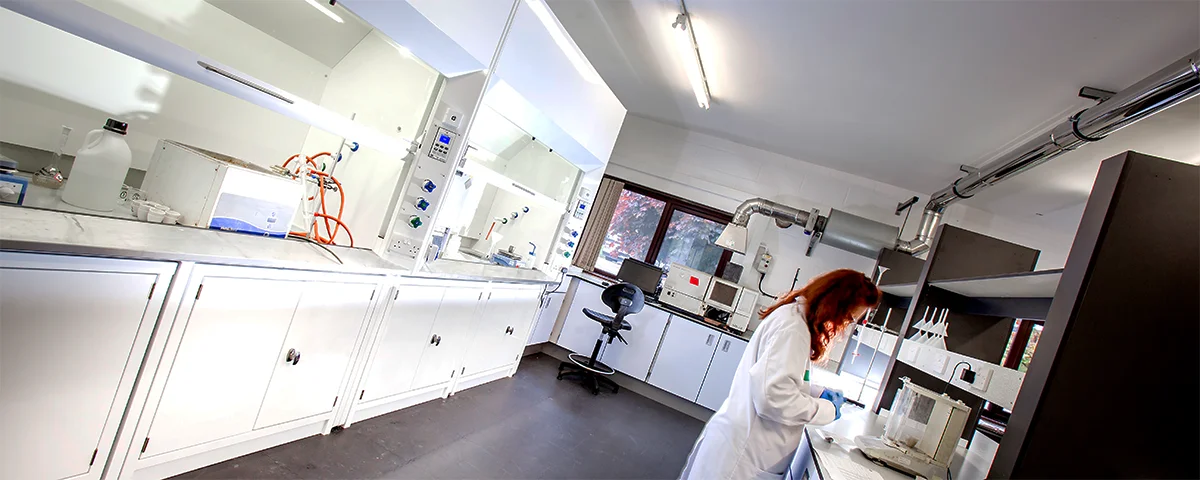Guide to Planning Laboratory Furniture
Table of Content
1. Introduction to lab furniture
Commercial laboratories, function as dynamic centres of innovation, fostering ground breaking discoveries and advancements across diverse fields and disciplines.
In educational environments, science laboratories serve as central hubs for hand-on learning, nurturing critical thinking and practical skills, while preparing students for future success.
Efficiently arranged and adequately engineered laboratory furniture and equipment is pivotal for enhancing productivity and safety across scientific, medical and research environments. Quality laboratory furniture is built to withstand demanding conditions such as chemical exposure, high temperature and the weight of heavy equipment. Its role is paramount in maintaining a functional workspace, preventing clutter and facilitating smooth operations.
2. Choosing a laboratory furniture manufacturer
When choosing a laboratory furniture manufacturer, there are a number of factors to consider, including the type of laboratory and furniture requirements, the specific needs of the scientists, and the budget.
- Research manufacturers: Prioritise reputable manufacturers with in-house production facilities and ISO 9001:2015 accreditation, who typically maintain better control over quality and production processes compared to those that outsource manufacturing.
- Get multiple quotes: When obtaining quotes from multiple manufacturers, it is crucial to ensure you’re comparing products with similar specifications to accurately assess value. Since there are a range of price points for Lab furniture, it’s important to find furniture that fits within your budget while still meeting your needs.
- Evaluate value: Consider factors beyond the initial price, such as durability, quality, warranty, and customer service.
- Durability is beneficial, investing in furniture built to withstand rigours of daily use ensures longevity and minimises environmental impact.
- Quality encompasses both the craftsmanship and materials, impacting not just appearance but also functionality and safety.
- A comprehensive warranty provides peace of mind, offering protection against post-purchase defects or issues.
- Attentive customer service enhances the buying experience, providing timely assistance with queries, concerns and post purchase support needs.
By carefully evaluating these aspects alongside the price, you can make a well-informed decision that maximises the value of your investment in lab furniture.
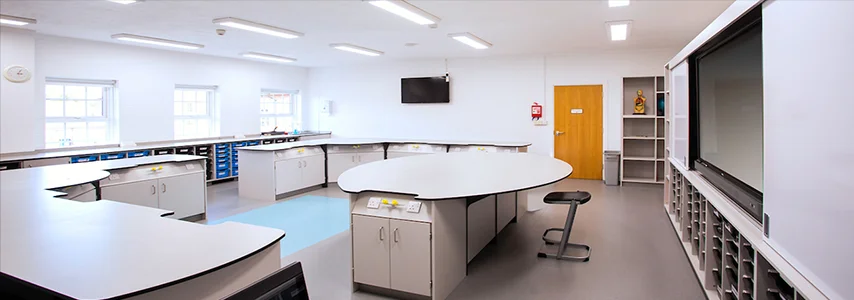
3. Key types of laboratories
The specific attributes of your laboratory, determines the necessary furniture and safety protocols. Prioritise the creation of ample circulation space, enhance accessibility and ensure strict adherence to regulations.
Flexible furniture – whether it’s mobile, semi-mobile or modular – enables users to accommodate diverse projects, workflows, team sizes, and equipment changes. This adaptability future-proofs your space, minimising unnecessary expenses when work or priorities shift. It also offers the freedom to avoid major alterations.
Conversely fixed benching in chemical laboratories offers stability, essential utilities and durability, ensuring equipment security, workflow efficiency, and reducing maintenance expenses.
Different laboratory environments demand specific furniture tailored to their distinct needs and safety protocols. Below is a comprehensive overview of the key laboratory types and essential considerations:
a) Commercial Laboratories
Commercial laboratories are adaptable environments that can accommodate high throughput testing and research. Robust and modular furniture is ideal, as it can be reconfigured as necessary. This includes durable lab benches, mobile storage, and adaptable shelving systems that can support diverse projects and team sizes.
When planning your space, carefully consider circulation space, particularly when handling hazardous materials, alongside your requirement for utilities and larger, fixed laboratory equipment. Determine the location of electrical outlets, gas taps, PCs, telephones, sinks, fridges, hand-wash stations and fume hoods.
Arrange instruments and smaller bench-top equipment for convenient access and safe-usage. Additionally ensure that all materials or finishes can withstand substances you will be working with and that all surfaces are durable and easy to maintain.
Laboratory projects frequently involve repetitive tasks and extended hours, highlighting the importance of ergonomically designed lab tables and chairs. Ensure that laboratory cabinets and shelving are strategically positioned for easy access to commonly used items.
b) Pharmaceutical Laboratories
Pharmaceutical laboratories are dedicated to developing and testing drug products, demanding meticulously hygienic environments. Stainless steel furniture is frequently employed for its non-porous properties and ease of sanitation. Work surfaces and seating must adhere to stringent cleanliness and contamination control standards, while secure storage for sensitive materials is indispensable.
For instance, cleanrooms emphasise the reduction of particulate, microbial and chemical contamination, with stainless steel or Trespa Toblab® being the preferred material due to its exceptional durability, chemical resistance, and ease of maintenance. Similarly In cold rooms furniture must withstand low temperature without degradation, which is why stainless steel is a preferred choice for its resistance to rust and corrosion.
c) Wet Laboratories
Wet labs are designed for experiments involving liquids, chemicals, and biological substances, necessitating furniture highly resistant to water and chemical spills. Commonly used are epoxy/Phenolic resin work surfaces like Trespa Toblab® or Stainless-steel, as they endure harsh chemicals, resistant to bacteria and are easy to clean. Cabinets and shelving must also resist chemicals, while seating should be easily cleanable and durable.
Fume cupboards are essential for ventilation, and storage units must include chemical storage cabinets or cupboards for safe storage of flammable or hazardous chemicals.
Controlled environments are often necessary in specialist labs, ensuring precise control over temperature and humidity, effective ventilation, and air filtration to prevent contamination and safeguard scientists and substances alike.
Following Health, Safety and Environment (HSE) guidelines, safeguarding against liquid hazards in laboratories is imperative. This involves the installation of safety showers, eyewash units, and exposure control devices to ensure the protection of laboratory personnel.
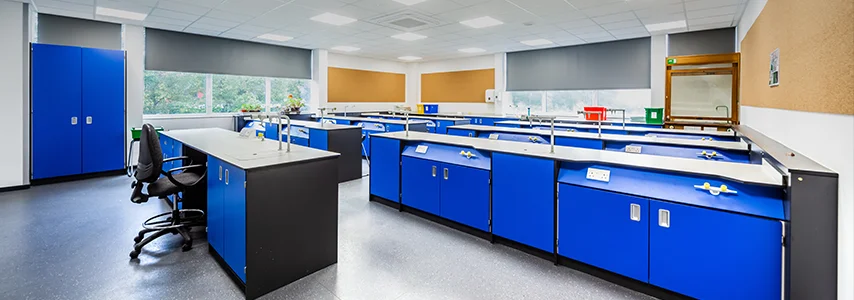
d) Dry Laboratories
Dry labs primarily deal with computational or electronic tasks requiring minimal use of chemicals or liquids. The furniture in these laboratories, prioritise ergonomics and workflow organisation, featuring adjustable desks for computers and ample cabinetry for storing non-hazardous materials. The focus is on establishing a comfortable and efficient environment conducive to data analysis and theoretical work.
Dry labs pose a greater risk of electrostatic discharge (ESD). Environments housing electrically powered equipment, which generate heat, necessitate surface materials that mitigate static or sparks. Continuous operation of these labs relies heavily on factors like emergency power, adequate air supply, humidity control and exhaust management.
-
Analytical Rooms: Tailored Furniture for Sensitive Equipment
Instrument rooms house precise and often costly research instruments, requiring furniture that not only supports but also enhances the functionality of these tools. Specialised tables with vibration dampening features are vital for accommodating sensitive equipment such as microscopes or spectrometers. Additionally, instrument rooms may incorporate custom cabinetry designed to integrate seamlessly with the specific dimensions and requirements of the equipment, including considerations for heat output and cable management.
-
Physics Laboratories
Physics labs frequently house delicate measuring equipment requiring stable, vibration-free furniture. Heavy-duty, sturdy tables equipped with vibration absorption features are essential. Storage and workspace layouts are usually tailored to accommodate large or irregularly shaped equipment, and flexibility in furniture arrangement is a crucial factor to consider.

-
Electronics Laboratories
Electronics labs specialise in the design, assembly, and testing of electronic devices, which require static-free environments. Furniture such as ESD (Electrostatic Discharge) workbenches, featuring grounded mats and shelves, is essential to prevent static electricity that could potentially damage sensitive components. Additionally, storage for delicate parts and tools must be specially designed to safequard against static buildup.
e) SEN Laboratories
In recent years there has been a welcome increase in the provision of specialised facilities for pupils with SEND. This shift is complemented by a growing recognition that catering to these students necessitates a personalised approach departing from traditional school design practices. It’s the only way to ensure that every student, has the opportunity to thrive and achieve their full potential.
SEN labs (Special Educational Needs) prioritise accessibility and safety, accommodating users of all abilities, including those with disabilities. Furniture in these labs is usually customisable and adaptable, featuring height adjustable tables and desks. Service hubs offer various options for gas and power accessibility, catering to wheelchair users and others with different needs. Perimeter benching can include a height adjustable sink and accessible tap controls. Additionally, a fully equipped demonstration bench and fume cupboard is ideal for presentations. Adequate space is allocated around equipment and machines for users with mobility aids, specialist/adapted equipment or wheelchair. Safety features include emergency cut off points for services with easy access for staff, as well as visual and auditory alarms.
Ultimately emphasising safety and ease of use, ensures all users, can actively engage in laboratory activities.
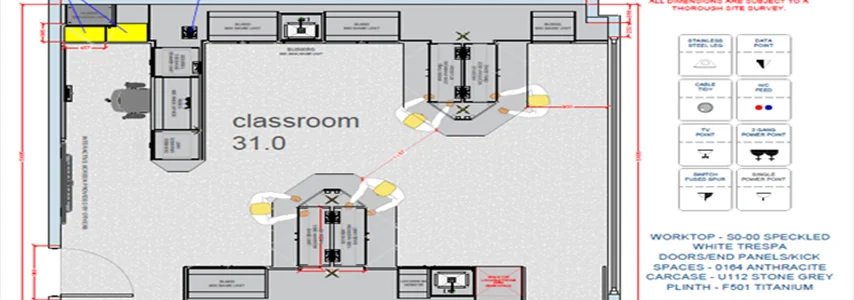
4. Fixed Vs mobile workspaces
Selecting the appropriate furniture for your lab can be challenging, given the multitude of options available today’s market. However, simplifying your search becomes easier when you focus on key factors relevant to your specific application.
When deciding between fixed or mobile furniture for your lab, consider the environmental conditions it will encounter. Additionally assess the equipment you will be using and determine if it requires specialised furniture, such as size, stability, temperature resistance and other factors. Consider whether your workspaces need to accommodate various tasks or if each station will serve specific function to streamline your workflow. By combining both fixed and mobile furniture options, you can effectively optimise the efficiency of your laboratory operations.
a) Fitted Laboratory Furniture
Most lab furniture is designated to be permanently installed in a pre-determined area, including cabinets, shelving and workbenches, creating a stable and stationary structure within the designated space. While they can be installed in various configurations, based upon the type of furniture being utilised. For example, shelving units can be affixed to walls to aid organisation, while workbenches can be securely anchored from the floor.
In educational environments, fixed furniture is often favoured for safety reasons, as it reduces the risk of students tripping or falling. However fixed benching may limit opportunities for easy group collaboration and may not provide the highest level of accessibility for various tasks.
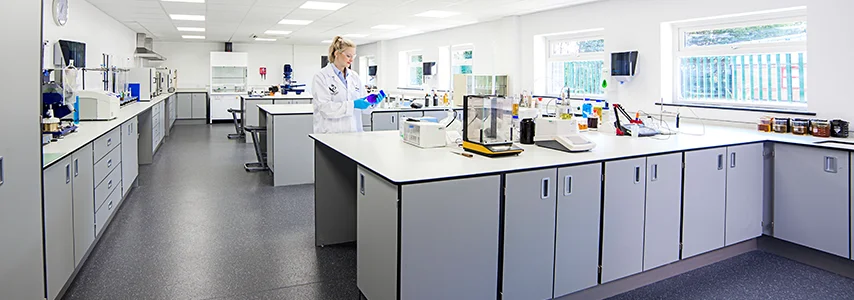
b) Mobile Laboratory Furniture
Flexible furniture presents a versatile solution for a wide range of applications, making it a popular choice for many university and commercial laboratory environments. Whether used partially or fully, it allows for a flexible laboratory design, optimising space. Education facilities may require classrooms to serve various purposes and mobile furniture simplifies this process.
In multi-purpose rooms, flexible furniture provides the versatility to add or remove workbenches and workstations as and when required. Cabinets that can be moved under fixed benching, ensures convenient access with minimal disruption to the workspace.
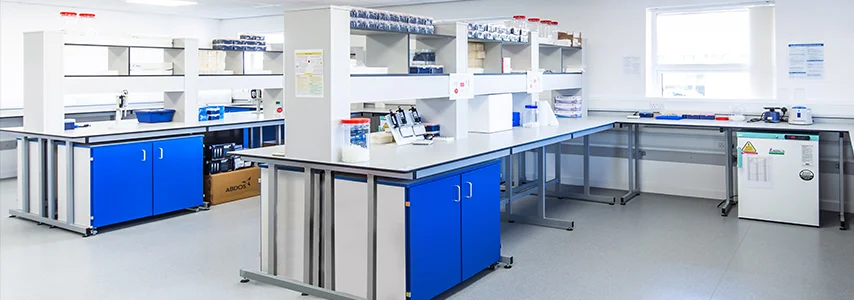
5. Evaluate your specific needs
Enhancing productivity and operational efficiency in the workspace is facilitated by a well-organised laboratory. Tailored workstations and shelving solutions prove invaluable in establishing a streamlined process in the lab.
Start by assessing your lab’s specific requirements. Consider factors such as the type of experiments conducted, the number of personnel, the types of chemicals stored, and any specialised equipment that needs to be accommodated. This will help you determine the type and quantity of furniture required.
- Budget: Set a budget for your lab furniture. Determine how much you are willing to spend, keeping in mind that quality and durability are important factors to consider. Look for furniture options that provide the best value for your money without compromising on quality.
- Aesthetics: While functionality and safety are paramount, the aesthetics of your laboratory should not be overlooked. A well-designed lab creates a positive work environment, boosting morale and productivity among lab personnel.
- Durability: Laboratory furniture needs to withstand daily wear and tear. Opting for durable options not only extends their lifespan and reduces the need for frequent replacements but also contributes to the environmental sustainability and guarantees long-term cost savings.
- Safety Standards: Laboratories have specific safety regulations that need to be adhered to. Ensure that the furniture you choose meets the necessary safety standards and is designed to minimise risks. Look for features such as chemical-resistant materials, fire-resistant coatings, and proper ventilation systems.
- Flexibility and Adaptability: Laboratories often undergo changes and upgrades. Choose furniture that is flexible and adaptable, allowing for modifications and re-configurations as needed. This will ensure that your lab remains functional and efficient even as your needs evolve.
- Ergonomics: Ergonomic furniture is essential for the comfort and well-being of lab personnel. Look for adjustable chairs and workstations that can be customised to individual needs. Ergonomic furniture reduces the risk of musculoskeletal disorders and improves productivity.
6. Laboratory furniture selection
Choosing the right furniture for your lab is vital for both functionality and safety. Every element, from lab benches and workstations to storage cabinets and ergonomic chairs, plays a pivotal role in creating a productive and efficient workspace. But with so many options available, it can be overwhelming to make the right choice.
In this comprehensive guide we provide an overview of key furniture considerations, when setting up different types of laboratories, including Chemistry, Physics, Microbiology, Research Laboratory, and more.
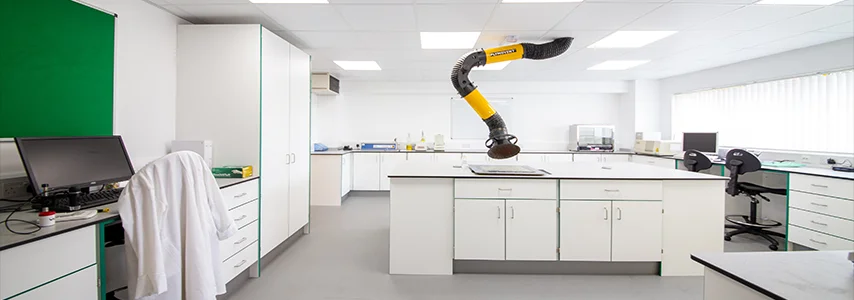
a) Workbenches and Worktops
Designing the layout of laboratory benching involves careful consideration of functionality, efficiency and safety. Key fixtures like Island, wall, perimeter benching along with reagent shelves and worksurfaces are essential in laboratories across various sectors including research, industrial, healthcare, education and clean room applications.
Manufactured from robust materials and tailored to the appropriate height and size for user comfort, these fixtures are engineered to withstand chemical spills, contamination and other challenges. Together they optimise workflow, support experimentation, streamline equipment handling ensuring seamless task performance in diverse laboratory environments.
Benching systems are available in several options including fixed plinth-based systems, flexible C-frame or H- frame configurations with castor systems. The choice depends on future expansion plans, as selecting the appropriate furniture configuration is critical in accommodating growth effectively.
Leveraging Innova’s modern, manufacturing facility, our skilled professionals can produce, customised products precisely tailored to your requirement.
- Material: Workbenches and tops are available in a range of materials, including stainless steel, epoxy resin, and chemical-resistant laminate. Each material has its own advantages and suitability for different applications. Consider factors such as chemical resistance, durability, and ease of cleaning when selecting the material.
- Size and Configuration: Workbenches and worksurfaces come in various sizes and configurations. Consider the available space in your lab and the specific tasks that will be performed when determining the size and layout of your workbenches. Ensure there is ample workspace and storage options to accommodate your needs.
- Mobile Furniture: Modular workbenches provide flexibility, enabling seamless future expansion or reconfiguration. Opting for such systems, ensures adaptability to evolving needs, facilitating easy modification as requirement changes over time.
b) Services & Sink Units
A well-designed laboratory infrastructure is crucial for smooth operations and facilitating groundbreaking discoveries. Central to achieving this, is the optimisation of utility distribution, including electricity, water, gas systems, to enhance productivity, safety and scientific innovation.
Innova provides a comprehensive range of products and turnkey services, guaranteeing a smooth hassle-free project management process and minimising potential risks.
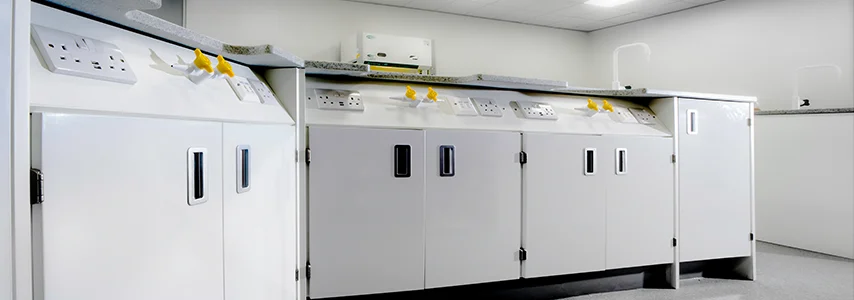
Selecting the right water and gas taps as well as sinks is pivotal to ensure both safety and efficiency. Water taps should allow precise control of flow rates and temperatures, while gas taps must be equipped with secure shut-off mechanisms to prevent leaks. Sinks must be durable, easy to clean and positioned to support seamless workflow. These considerations enhance user convenience, mitigate potential hazards and promote a productive and compliant laboratory environment.
-
Lab Water Taps
Our selection of laboratory water taps from single, double, mixer to heavy duty models with 5” goosenecks and wristband handles, bib taps are available in a range of configurations and heights engineered to withstand bending, breakages and disassembly.
- Lab Gas Taps
Laboratory gas taps are vital components in scientific environments, facilitating the safe and controlled delivery of various gases for experiments and processes.
Gas taps come in a variety of designs, including drop lever, lift and turn and needle valves, available in one way, two way or four-way configurations. These taps are typically made from materials that guarantee durability, corrosion resistance and safety. Common materials include brass, stainless steel, aluminium among others. The choice of material depends on the type of gas being handled and the specific operating conditions of the laboratory environment.
Gas taps are securely installed to prevent rotation causing potential hazards like fracturing gas connections.
-
Lab Sinks
Innova offers a variety of laboratory sink options in different sizes including stainless steel, epoxy resin, ceramic and solid surface, designed to accommodate diverse application, withstand daily usage and facilitate effortless cleaning.
Cost, functionality and aesthetics are important considerations.
The most popular material for sinks is stainless steel, available in a variety of types, styles and sizes, these sinks are visually appealing, easy to clean and resistant to stains and rust.
Epoxy resin sinks offer durability, exceptional chemical and stain resistance, mechanical strength, hygiene and easy maintenance making them ideal for laboratory use. Marine edged epoxy resin sinks are specifically designed to prevent spills and facilitate easy cleaning by eliminating crevices where dirt and bacteria can accumulate. Unlike traditional raised rims, marine edges feature a sloped or curved profile that seamlessly blends with the worktop surface.
Traditional ceramic sinks often referred to as Belfast sinks, feature a smooth, impermeable surface, that resists chemicals, dirt and moisture. This durable option can withstand heat and stains while retaining its colour. Additionally ceramic sinks are highly resistant to scratches and chipping, ensuring long-lasting functionality and aesthetic appeal.
Solid surface sinks – Truly high-performance sink which can be integrated into the worktop for a smooth, streamlined appearance that’s super easy to clean. Withstands most common chemicals, non -porous so won’t harbour dirt, absorb moisture or bacteria. Easy to repair and maintain.
Innova offers a range of solutions including undermount or inset into base units as appropriate.
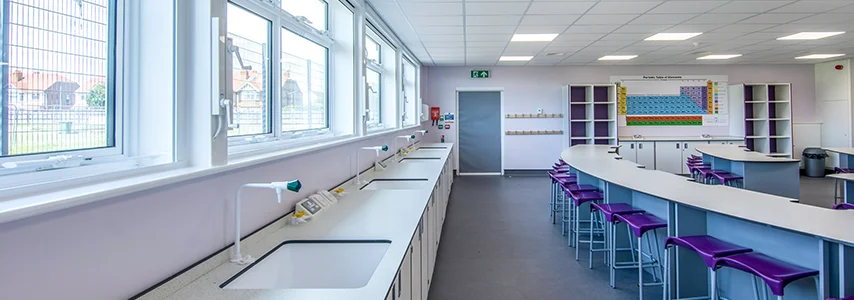
c) Desks & Tables with fully welded frames
Lab tables and desking provide versatility in any laboratory environment, easily reconfigurable to support a wide array of activities and teaching methodologies. Their adjustable features and modular designs, make them ideal for facilitating experiments, collaborative work, and hand-on practical sessions. Available in diverse styles and sizes, these products optimise space utilisation and enhance workflow efficiency.
Innova’s durable H-frame lab tables, featuring a central footrest, are engineered to endure rigorous usage. Whether utilised independently or integrated into our pedestal and cantilever furniture systems, these products enhance the flexibility and productivity of your laboratories, workspaces and classrooms.
Depending on the application and expected load bearing requirements, we can tailor our products to your specifications in terms of shape, colour, size or height. Innova’s laboratory tables are available in a choice of 16mm Trespa, 25mm Velstone or 25mm MFMDF worktops, all supported by robust, fully welded powder coated steel legs and levelling feet to guarantee stability on uneven floors.
Furthermore, our mobile units feature heavy-duty lockable castors for effortless movement and portability.
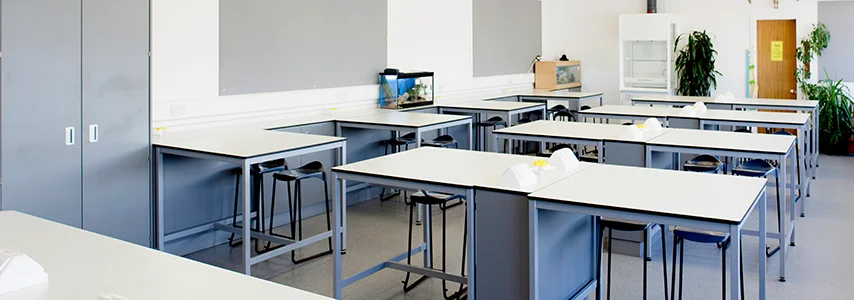
-
Height Adjustable Tables
Innova’s height-adjustable laboratory desks and tables are fully compliant with Disability Discrimination Act (DDA) standards and are designed to accommodate various working positions, ensuring inclusivity for all students and employees in any environment. These tables are custom-made to your specification including colours and materials and worktops.
Furthermore, we offer desks fully equipped with multiple services such as electric outlets, sinks or taps and all our height-adjustable desks can be operated either electrically or manually with a crank handle.
-
Anti-Vibration Balance Tables
Anti-vibration balance tables are essential for maintaining precision and accuracy in sensitive experiments with balances, microscopes and other high-precision instruments. These tables are constructed with a heavy-duty steel frame box 60x60mm featuring welded joints and filled with silica sand, to enhance vibration protection. Mounted on a fully welded plate with adjustable feet these tables ensure stability.
At the frame’s top, anti-vibration mounts are strategically placed to support a double thickness Trespa or Velstone work surface, which floats above the frame, further enhancing vibration resistance.
d) Smart Storage
Effective laboratory storage is essential for both safety and functionality. A well-designed storage system not only prevents unnecessary equipment replacement costs but also promotes a clean, safe and organised workspace.
Innova specialises in practical laboratory storage solutions, offering a variety of options from traditional pedestal cupboards to mobile under-bench systems.
Our selection encompasses open storage in various depths and heights, options for burette and pipette, various types of cupboards including tall, wall and under-bench, topline drawers, drawer combinations, gratnell tray storage and other storage solutions.
These space-saving solutions are durable, versatile and practical, ensuring efficient utilisation of your laboratory space, while maintaining a high standard of organisation and safety.
e) Fume Extraction Systems
All types of laboratories need fume extraction, to mitigate exposure to hazardous substances like gases, vapours, aerosols and particulates, ensuring a healthier and safer environment. Installing appropriate laboratory extraction equipment including fume hoods and cupboards, is vital for providing adequate protection for lab users and complying with UK health and safety regulations.
At Innova we offer a diverse range of laboratory extraction equipment as part of our comprehensive lab furniture packages.
- Ducted and Filtered (Recirculating) Fume Cupboards
- Semi mobile ducted or fully mobile
- Class I and II Microbiological Safety Cabinets
- Laminar Flow Workstations
- Chemical Storage Cupboard
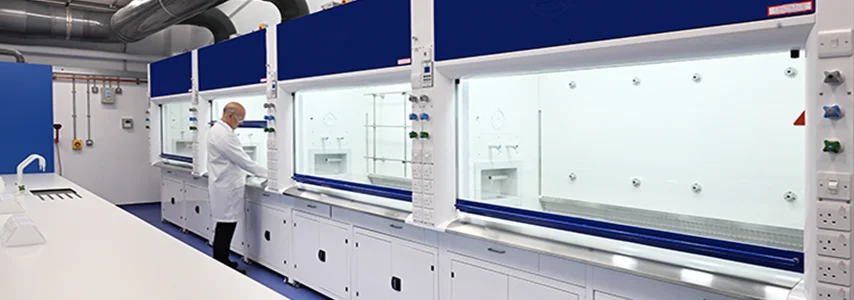
f) Seating
At Innova we offer an excellent range of quality, stylish, ergonomic stools, suitable for the demands of a research or educational laboratory environments. Choose from variety of styles, colours and finishes, each offering, customisable safety features and durability to suit your specific requirements.
Additionally we offer draughtman’s chairs, perfect for users requiring elevated seating. These chairs are adjustable to your desk and provide much needed comfort, when working long hours. Stools provide the flexibility for students to work more productively during practical sessions as they can alternate between sitting and standing positions comfortably.
7. Conclusion
Selecting the right lab furniture is vital to establish a safe, efficient, and productive working environment. A thorough understanding of the diverse furniture options and their specific purposes ensures laboratories are equipped to address any scientific challenge encountered now and well into the future.

